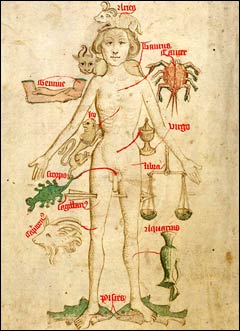
Zodiac Man; or, Homo signorum, c1486.
Zodiac Man: Man as Microcosm
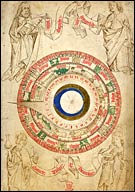
A volvelle.
|
Part of the Medieval worldview was the idea that man was a microcosm ("a little world") which reflected the macrocosm of the Ptolemaic universe. As the Earth was divided into regions influenced by the planets, similarly the body of man was divided into "regions" governed by signs of the Zodiac. Astrological signs were thought to influence the body and its health, and sketches of the "Zodiac Man" are common in medical treatises of the Middle Ages. These diagrams instructed doctors and barber-surgeons whether it was safe to bleed a patient or to perform surgery; if the moon was in the sign of the bodypart in question, it was not recommended.1 The position of the moon could be determined with a volvelle — a rotating calendar.
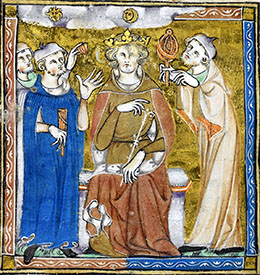
King consulting both astrologer and doctor, c1327.
The concept of man as microcosm is thought to originate with the ancient Babylonians. The Egyptians [image 1; image 2; image 3] and the Mayans [image] had analogues, and ancient Mithraic [image 1; image 2], Hebrew [image 1; image 2], Chinese, and Vedic traditions also contain similar concepts. Microcosmic ideas are fleshed out in the works of Plato (4th-c. BCE), but the first use of the term "microcosmos" in Western philosophy appears later, briefly, in Aristotle's Physics.2 In the first century A.D. the Roman writer Manilius stated in his Astronomicon that man contained a world in himself, being created in the image of God.3 Numerous writers, including Firmicus (4th-c.) and Macrobius (5th-c.), to name a few, followed along the same lines. The first modern use of the terms macrocosmos and microcosmos, shortened to macrocosm/microcosm, was by Pico della Mirandola in his Heptaplus in 1490.4
Zodiac anatomy in medical astrology: 5
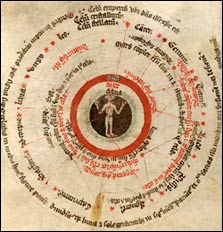
|
Aries — Head
Taurus — Neck
Gemini — Arms & shoulders
Cancer — Breast
Leo — Shoulderblades & Sides
Virgo — Stomach & intestines
Libra — Hips & buttocks
Scorpio — Genitals
Sagittarius — Thighs
Capricorn — Knees
Aquarius — Ankles
Pisces — Feet
|
There were several subsequent variations and expansions, of course. The idea of man as microcosm was popular long after the Middle Ages and was often used as a poetical conceit (e.g. John Donne's 'Holy Sonnet 5': "I am a little world made cunningly"). Some hermetic and occult traditions embrace the idea of the microcosmic man still today.
Zodiac Man Images from Medieval Manuscripts:
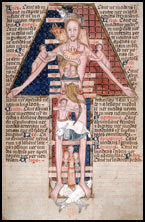
Zodiac Man, late 14th-c. |
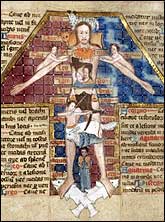
Zodiac Man, after 1387. |
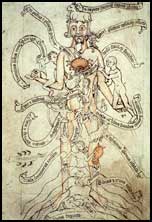
Zodiac Man, after 1387. |
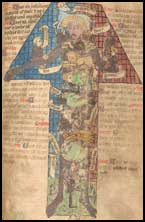
Zodiac Man, 14th c. |
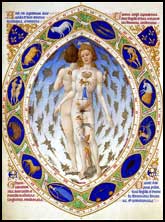
Zodiac Man, 1413. |
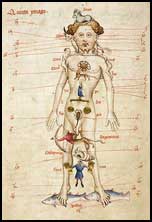
Zodiac Man, 1408. |
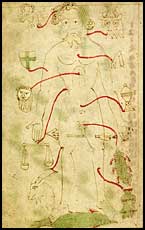
Zodiac Man, 1411-12. |
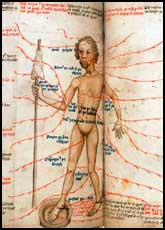
Zodiac Man, 15th c. |
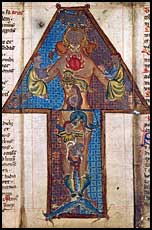
Zodiac Man, c1406. |
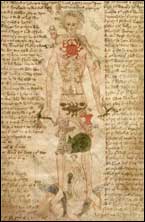
Zodiac Man, early 15th-c. |
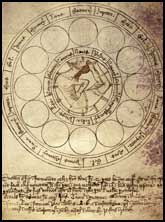
Zodiac Man, c1400 (?) |
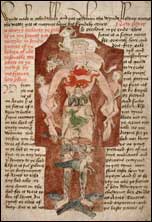
Zodiac Man, c1440. |
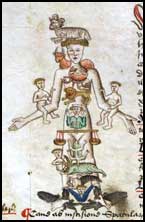
Zodiac Man, c1425-50. |
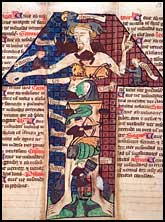
Zodiac Man, c1400-50. |
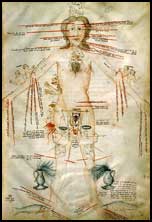
Zodiac Man, c1450. |
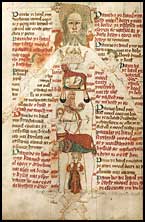
Zodiac Man, 1488-9. |
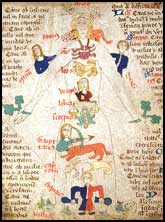
Zodiac Man, c1490. |
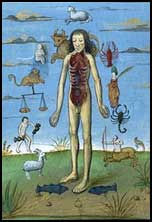
Zodiac Man, late 15th-c. |
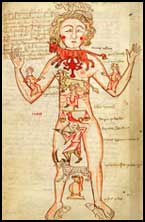
Zodiac Man, 15th-c. |
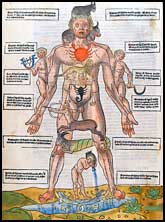
Zodiac Man, 1493. |
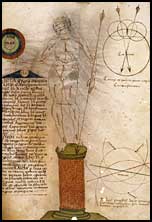
Zodiac Man, 16th-c. |
- Sophie Page. Astrology in Medieval Manuscripts.
Toronto: University of Toronto Press, 2002. 54.
- George Perrigo Conger. Theories of Macrocosms and Microcosms in the History of Philosophy.
New York: Columbia University Press, 1922. 11.
- ib. 25.
- Lawrence Parmly Brown. "The Cosmic Man and Homo Signorum." The Open Court, v35.
Chicago: The Open Court Publishing Company, 1921. 27.
- Manilius, in Book 4 of Astronomicon, writes:
"Namque Aries capiti, Taurus cervicibus hæret;
Brachia sub Geminis censentur, pectora Cancro;
Te, scapulæ, Nemæe, vocant, teque ilia, Virgo;
Libra colit clunes, et Scorpius inguine regnat;
Et femur Arcitenens, genua et Capricornus amavit;
Cruraque defendit Juvenis, vestigia, Pisces."
- http://www.luminarium.org/encyclopedia/zodiacman.htm
|

